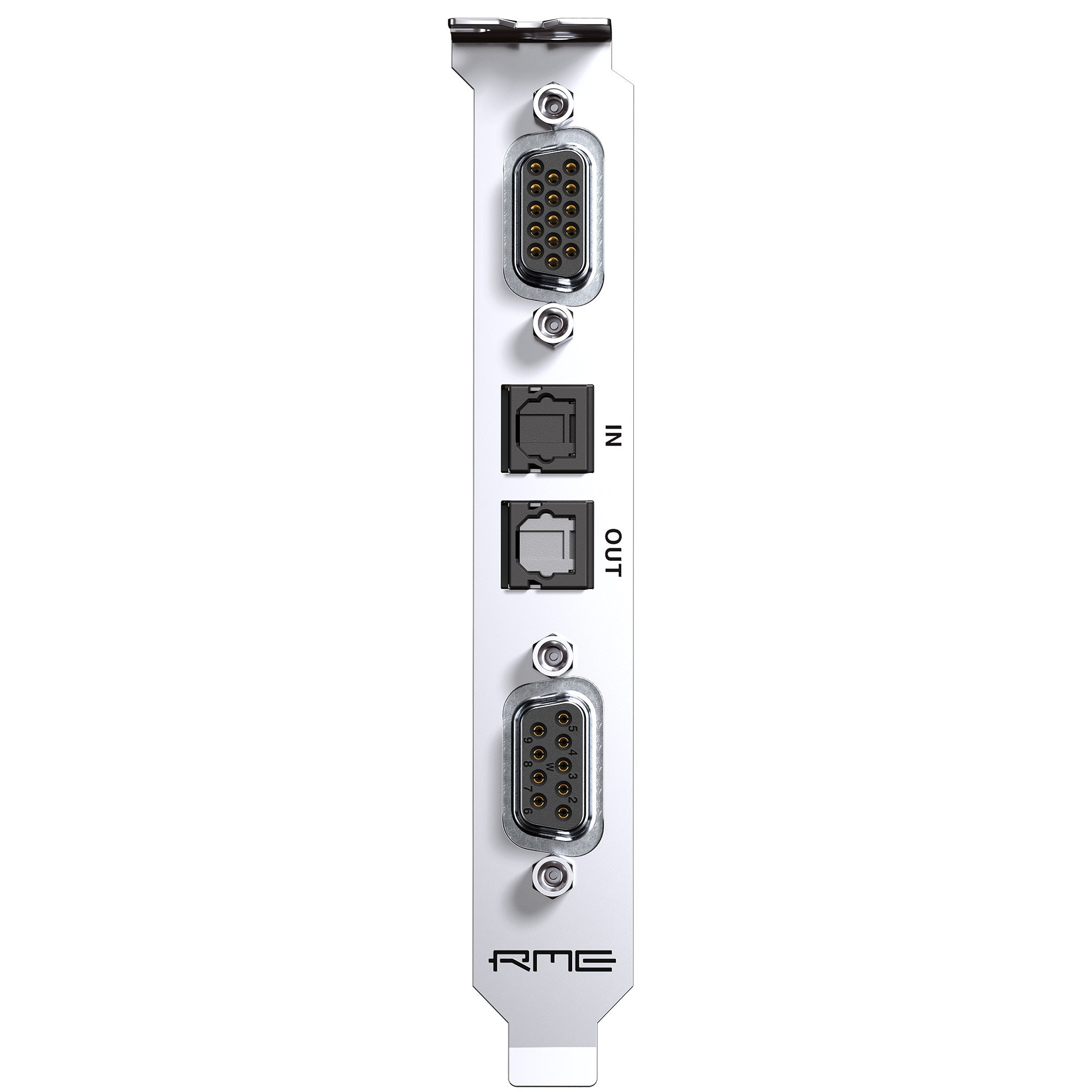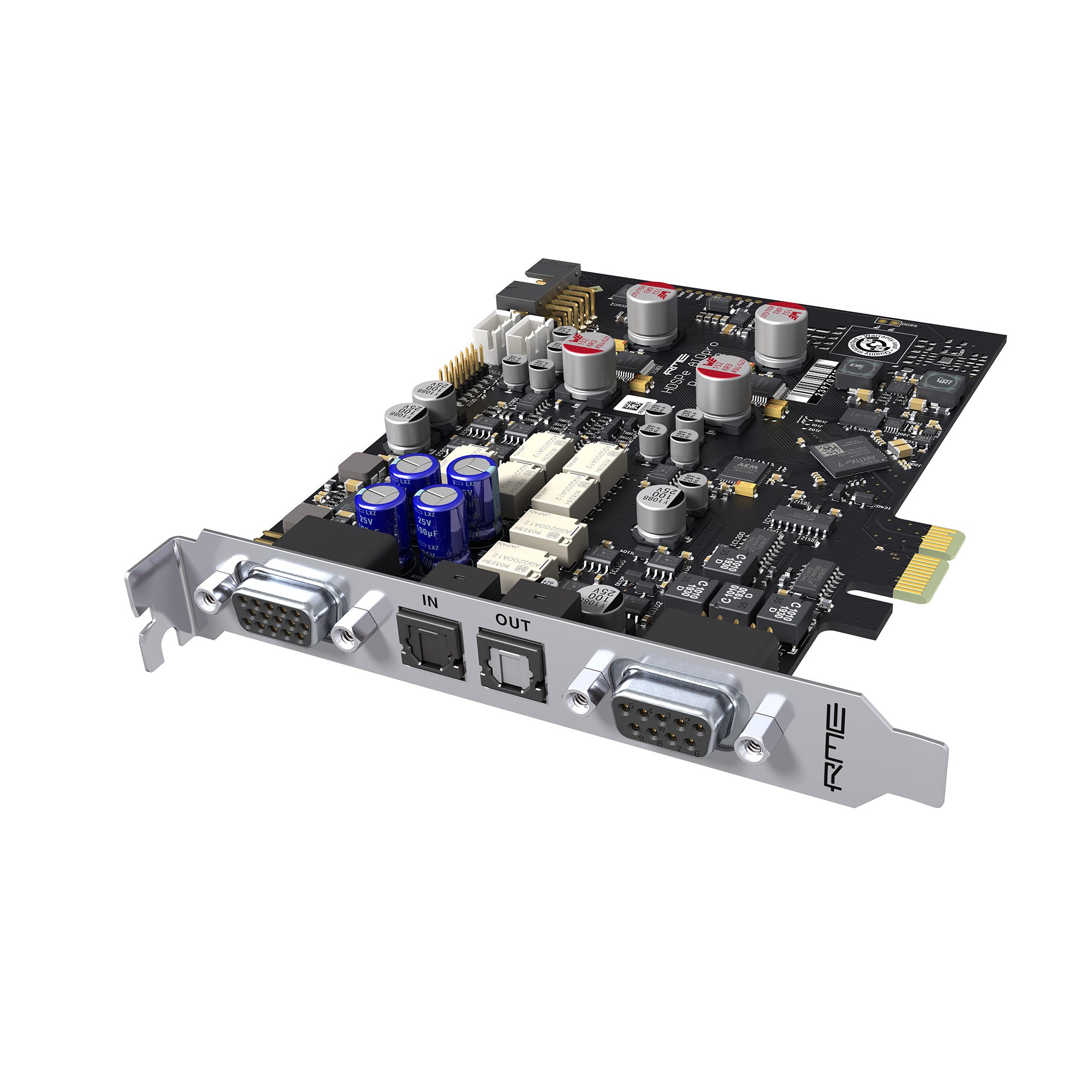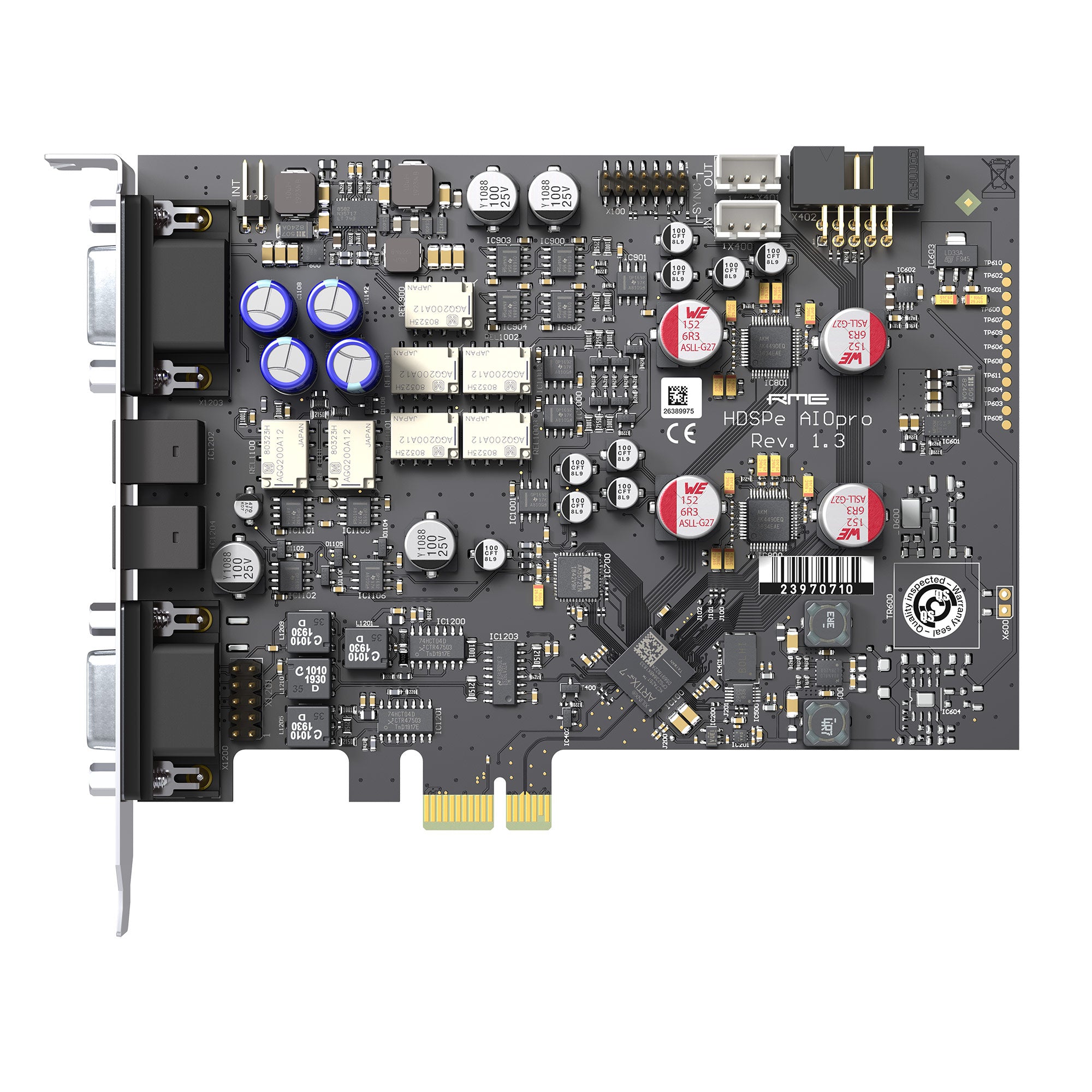
Description
RME introduces the HDSPe AIO Pro PCI Express interface card, the successor of the popular HDSPe AIO. The Pro version provides professional users in the fields of studio and broadcast with the same high channel count as well as analog/digital input and output variety of the HDSPe AIO. In terms of technical features RME has completely reworked the HDSPe AIO Pro, defining the current state-of-the-art in PCI Express cards.
All inputs and outputs are simultaneously operational, even SPDIF (phono) and AES/EBU (XLR). Of course TotalMix, the unsurpassed flexible routing mixer and SteadyClock FS, RME's sensational clock technology with maximum jitter suppression of external clock signals, are on board too. HDSPe AIO Pro also supports the optional TCO for synchronization to timecode (LTC/video).
Features:
- Balanced* stereo analog in- and output, 24-bit/192kHz
- All analog I/Os capable of 192 kHz, constant number of available channels
- 1 ADAT digital I/O, supporting 192 kHz via S/MUX4 operation
- 1 SPDIF digital I/O, 192 kHz-capable
- 1 AES/EBU digital I/O, 192 kHz-capable
- 1 High Power Headphone Output, separate DA-converter and playback device
- 1 MIDI I/O with 16 channels of hi-speed MIDI via breakout cable
- DIGICheck, RME's unique metering- and analysing tool
- TotalMix FX: 760 channel Mixer with 42 bit internal resolution
- Native PCI Express - no PCI to PCI Express bridge used
- Outputs with Mute Relais
- +24 dBu I/O Levels
The new HDSPe AIO Pro is based on the reference processors AK5572 and AK4490 derived from the high-end AD/DA converter ADI-2 Pro. The analog input range also uses the circuit design of the ADI-2 Pro (+24 / +19 / +13 / +4 dBu). In addition, RME has enhanced the outputs with additional reference levels (balanced: +24 / +19 / +13 / +4 dBu; unbalanced: +19 / +13 / +4 / -2 dBu) which allows even more versatile integration into audio systems. The HDSPe AIO Pro features a dedicated attenuator in the output section, resulting in an increased signal-to-noise ratio and a lower output impedance at low reference levels.
A further highlight of the HDSPe AIO Pro is the newly developed, powerful and extremely transparent headphone output. Thanks to mute relay including switchable output levels, there is no unwanted crackling noise at the headphone output and the analog XLR and RCA outputs when switching on the computer.
TotalMix FX - Mixing/Routing with superior features for Studio and Live Work
Since 2001 TotalMix added unlimited routing and mixing to RME‘s audio interfaces. Its unique capability to create as many independent submixes as output channels available turned it into the most flexible and powerful mixer of its kind.
SteadyClock FS - Reference class Digital Clocking
Excellent performance in all clock modes and High Quality Analog Conversion to hear your mix as it is, with lowest jitter and highest jitter immunity.
DigiCheck - The Secret Weapon of High Resolution Audio Measurements
RME Audio interfaces not only provide you with a professional digital audio interface, but also with a free available software tool: DigiCheck, for metering, testing, measuring and analyzing digital audio streams.
* The HDSPe AIO Pro ships in a basic version with analog RCA/phono breakout cables (headphone: TRS jack). Therefore all analog I/Os are unbalanced. An analog XLR breakout cable is available as option (headphone: Neutrik TRS locking jack), turning analog into balanced mode.
| Analog Inputs | |
| RCA (Standard D-Sub Breakout cable) | Input: Cinch (RCA), unbalanced Input impedance: 18 kOhm Input sensitivity switchable +24 dBu, +19 dBu, +13 dBu, +4 dBu @ 0 dBFS Signal to Noise ratio (SNR) @ +19/24 dBu: 117 dB RMS unweighted, 120 dBA Signal to Noise ratio (SNR) @ +13 dBu: 116 dB RMSu nweighted, 118 dBA Signal to Noise ratio (SNR) @ +4 dBu: 112 dB RMSu nweighted, 114 dBA Frequency response @ 44,1 kHz, -0,1 dB: 7 Hz Ð 20.5 kHz Frequency response @ 96 kHz, -0,5 dB: 3 Hz Ð 45,5 kHz Frequency response @ 192 kHz, -1 dB: 2 Hz Ð 92 kHz THD @ -1 dBFS: -114 dB, 0,0002 % THD+N @ -1 dBFS: -110 dB, 0,0003 % Channel separation:> 110 dB |
| XLR (optional D-Sub Breakout cable) as RCA, except: |
Input: XLR, servo-balanced Input impedance balanced: 36 kOhm, unbalanced: 18 kOhm Signal to Noise ratio(SNR) @ +4 dBu: 116 dB RMS unweighted, 118 dBA |
| Analog Outputs | |
| RCA (Standard D-Sub Breakout cable) | Output: Cinch (RCA), unbalanced Output impedance+19/+13 dBu: 75 Ohm. +4/-2 dBu: 80 Ohm Output impedance switchable +19, +13 dBu, +4 dBu, -2 dBu @ 0 dBFS Signal to Noise ratio (SNR) @ +19 dBu: 117 dB RMS unweighted, 119 dBA Signal to Noise ratio (SNR) @ +13 dBu: 116 dB RMS unweighted, 118 dBA Signal to Noise ratio (SNR) @ +4 dBu: 114 dB RMS unweighted, 116 dBA Signal to Noise ratio (SNR) @ -2 dBu: 110 dB RMS unweighted, 112 dBA Frequency response @ 44.1 kHz, -0,1 dB: 10 Hz Ð 20,2 kHz Frequency response @ 96 kHz, -0,5 dB: 4 Hz Ð 44,6 kHz Frequency response @ 192 kHz, -1 dB: 3 Hz Ð 83 kHz THD @ 0 dBFS: < -107 dB, 0,0005 % THD+N @ 0 dBFS: -105 dB, 0,0006 % Channel separation:> 110 dB |
| XLR (optional D-Sub Breakout cable) as RCA, except: |
Output: XLR Output impedance +24/+19 dBu: 150 Ohm, +13/+4 dBu: 160 Ohm Output level switchable +24 dBu, +19 dBu, +13 dBu, +4 dBu @ 0 dBFS Signal to Noise ratio (SNR) @ +24 dBu: 117 dB RMS unweighted, 120 dBA |
| Phones as RCA, except: |
Output: 6.3 mm TRS jack, unbalanced, stereo Output impedance: 0.1 Ohm Signal to Noise ratio (SNR) @ +19 dBu (Hi-Power): 117 dB RMS unweighted, 119 dBA Signal to Noise ratio (SNR) @ +7 dBu (Lo-Power): 113 dB RMS unweighted, 115 dBA Output level at 0 dBFS, Hi-Power, load 150 Ohm or up: +19 dBu (6.9 V) Output level at 0 dBFS, Lo-Power, load 16 Ohm or up: +7 dBu (1.73 V) THD+N @ + 15 dBu, 32 Ohm load, 590 mW: -97 dB, 0.0016 % Max power @ 0.1% THD 32 Ohm: 730 mW per channel |
| Digital Inputs | |
| AES/EBU | 1 x XLR, transformer-balanced, galvanically isolated, according to AES3-1992 High-sensitivity input stage (< 0,3 Vss) SPDIF compatible (IEC 60958) Accepts Consumer and Professional format, copy protection will be ignored Lock Range: 28 kHz Ð 200 kHz |
| SPDIF | 1 x RCA, transformer-balanced, according to IEC 60958 High-sensitivity input stage (< 0,3 Vss) AES/EBU compatible (AES3-1992) Accepts Consumer and Professional format, copy protection will be ignored Lock Range: 28 kHz Ð 200 kHz |
| ADAT Optical | 1 x TOSLINK, format according to Alesis specification Standard: 8 channels 24 bit, up to 48 kHz Double Speed (S/MUX): 4 channels 24 bit 96 kHz Quad Speed (S/MUX4): 2 channels 24 bit 192 kHz Bitclock PLL ensures perfect synchronisation even in varispeed operation Lock range: 31.5 kHz Ð 50 kHz |
| Digital Outputs | |
| AES/EBU | 1 x XLR, transformer-balanced, galvanically isolated, according to AES3-1992 Output level 4,0 Vss Format Professional according to AES3-1992 Amendment 4 Single Wire mode, sample rate 28 kHz up to 200 kHz |
| SPDIF | 1 x RCA, transformer-balanced, according to IEC 60958 Output level Professional 2.3 Vpp, Consumer 1.0 Vpp Format Professional according to AES3-1992 Amendment 4 Format Consumer SPDIF according to IEC 60958 Single Wire mode, sample rate 28 kHz up to 200 kHz |
| ADAT | 1 x TOSLINK, format according to Alesis specification Standard: 8 channels 24 bit, up to 48 kHz Double Speed (S/MUX): 4 channels 24 bit 96 kHz Quad Speed (S/MUX4): 2 channels 24 bit 192 kHz |
| Digital | Clocks: Intern, ADAT In, SPDIF In, Sync In, optional Word clock In / LTC in Jitter suppression of external clocks:> 50 dB (2,4 kHz) Effective clock jitter influence on AD and DA conversion: near zero PLL ensures zero dropout, even at more than 100 ns jitter Digital Bitclock PLL for trouble-free varispeed ADAT operation Supported sample rates: 28 kHz up to 200 kHz |
| MIDI | 1 x MIDI I/O via 5-pin DIN jacks Galvanically isolated by optocoupled input Hi-speed mode: Jitter and response time typically below 1 ms Separate 128 byte FIFOs for input and output |
RME introduces the HDSPe AIO Pro PCI Express interface card, the successor of the popular HDSPe AIO. The Pro version provides professional users in the fields of studio and broadcast with the same high channel count as well as analog/digital input and output variety of the HDSPe AIO. In terms of technical features RME has completely reworked the HDSPe AIO Pro, defining the current state-of-the-art in PCI Express cards.
All inputs and outputs are simultaneously operational, even SPDIF (phono) and AES/EBU (XLR). Of course TotalMix, the unsurpassed flexible routing mixer and SteadyClock FS, RME's sensational clock technology with maximum jitter suppression of external clock signals, are on board too. HDSPe AIO Pro also supports the optional TCO for synchronization to timecode (LTC/video).
Features:
- Balanced* stereo analog in- and output, 24-bit/192kHz
- All analog I/Os capable of 192 kHz, constant number of available channels
- 1 ADAT digital I/O, supporting 192 kHz via S/MUX4 operation
- 1 SPDIF digital I/O, 192 kHz-capable
- 1 AES/EBU digital I/O, 192 kHz-capable
- 1 High Power Headphone Output, separate DA-converter and playback device
- 1 MIDI I/O with 16 channels of hi-speed MIDI via breakout cable
- DIGICheck, RME's unique metering- and analysing tool
- TotalMix FX: 760 channel Mixer with 42 bit internal resolution
- Native PCI Express - no PCI to PCI Express bridge used
- Outputs with Mute Relais
- +24 dBu I/O Levels
The new HDSPe AIO Pro is based on the reference processors AK5572 and AK4490 derived from the high-end AD/DA converter ADI-2 Pro. The analog input range also uses the circuit design of the ADI-2 Pro (+24 / +19 / +13 / +4 dBu). In addition, RME has enhanced the outputs with additional reference levels (balanced: +24 / +19 / +13 / +4 dBu; unbalanced: +19 / +13 / +4 / -2 dBu) which allows even more versatile integration into audio systems. The HDSPe AIO Pro features a dedicated attenuator in the output section, resulting in an increased signal-to-noise ratio and a lower output impedance at low reference levels.
A further highlight of the HDSPe AIO Pro is the newly developed, powerful and extremely transparent headphone output. Thanks to mute relay including switchable output levels, there is no unwanted crackling noise at the headphone output and the analog XLR and RCA outputs when switching on the computer.
TotalMix FX - Mixing/Routing with superior features for Studio and Live Work
Since 2001 TotalMix added unlimited routing and mixing to RME‘s audio interfaces. Its unique capability to create as many independent submixes as output channels available turned it into the most flexible and powerful mixer of its kind.
SteadyClock FS - Reference class Digital Clocking
Excellent performance in all clock modes and High Quality Analog Conversion to hear your mix as it is, with lowest jitter and highest jitter immunity.
DigiCheck - The Secret Weapon of High Resolution Audio Measurements
RME Audio interfaces not only provide you with a professional digital audio interface, but also with a free available software tool: DigiCheck, for metering, testing, measuring and analyzing digital audio streams.
* The HDSPe AIO Pro ships in a basic version with analog RCA/phono breakout cables (headphone: TRS jack). Therefore all analog I/Os are unbalanced. An analog XLR breakout cable is available as option (headphone: Neutrik TRS locking jack), turning analog into balanced mode.
| Analog Inputs | |
| RCA (Standard D-Sub Breakout cable) | Input: Cinch (RCA), unbalanced Input impedance: 18 kOhm Input sensitivity switchable +24 dBu, +19 dBu, +13 dBu, +4 dBu @ 0 dBFS Signal to Noise ratio (SNR) @ +19/24 dBu: 117 dB RMS unweighted, 120 dBA Signal to Noise ratio (SNR) @ +13 dBu: 116 dB RMSu nweighted, 118 dBA Signal to Noise ratio (SNR) @ +4 dBu: 112 dB RMSu nweighted, 114 dBA Frequency response @ 44,1 kHz, -0,1 dB: 7 Hz Ð 20.5 kHz Frequency response @ 96 kHz, -0,5 dB: 3 Hz Ð 45,5 kHz Frequency response @ 192 kHz, -1 dB: 2 Hz Ð 92 kHz THD @ -1 dBFS: -114 dB, 0,0002 % THD+N @ -1 dBFS: -110 dB, 0,0003 % Channel separation:> 110 dB |
| XLR (optional D-Sub Breakout cable) as RCA, except: |
Input: XLR, servo-balanced Input impedance balanced: 36 kOhm, unbalanced: 18 kOhm Signal to Noise ratio(SNR) @ +4 dBu: 116 dB RMS unweighted, 118 dBA |
| Analog Outputs | |
| RCA (Standard D-Sub Breakout cable) | Output: Cinch (RCA), unbalanced Output impedance+19/+13 dBu: 75 Ohm. +4/-2 dBu: 80 Ohm Output impedance switchable +19, +13 dBu, +4 dBu, -2 dBu @ 0 dBFS Signal to Noise ratio (SNR) @ +19 dBu: 117 dB RMS unweighted, 119 dBA Signal to Noise ratio (SNR) @ +13 dBu: 116 dB RMS unweighted, 118 dBA Signal to Noise ratio (SNR) @ +4 dBu: 114 dB RMS unweighted, 116 dBA Signal to Noise ratio (SNR) @ -2 dBu: 110 dB RMS unweighted, 112 dBA Frequency response @ 44.1 kHz, -0,1 dB: 10 Hz Ð 20,2 kHz Frequency response @ 96 kHz, -0,5 dB: 4 Hz Ð 44,6 kHz Frequency response @ 192 kHz, -1 dB: 3 Hz Ð 83 kHz THD @ 0 dBFS: < -107 dB, 0,0005 % THD+N @ 0 dBFS: -105 dB, 0,0006 % Channel separation:> 110 dB |
| XLR (optional D-Sub Breakout cable) as RCA, except: |
Output: XLR Output impedance +24/+19 dBu: 150 Ohm, +13/+4 dBu: 160 Ohm Output level switchable +24 dBu, +19 dBu, +13 dBu, +4 dBu @ 0 dBFS Signal to Noise ratio (SNR) @ +24 dBu: 117 dB RMS unweighted, 120 dBA |
| Phones as RCA, except: |
Output: 6.3 mm TRS jack, unbalanced, stereo Output impedance: 0.1 Ohm Signal to Noise ratio (SNR) @ +19 dBu (Hi-Power): 117 dB RMS unweighted, 119 dBA Signal to Noise ratio (SNR) @ +7 dBu (Lo-Power): 113 dB RMS unweighted, 115 dBA Output level at 0 dBFS, Hi-Power, load 150 Ohm or up: +19 dBu (6.9 V) Output level at 0 dBFS, Lo-Power, load 16 Ohm or up: +7 dBu (1.73 V) THD+N @ + 15 dBu, 32 Ohm load, 590 mW: -97 dB, 0.0016 % Max power @ 0.1% THD 32 Ohm: 730 mW per channel |
| Digital Inputs | |
| AES/EBU | 1 x XLR, transformer-balanced, galvanically isolated, according to AES3-1992 High-sensitivity input stage (< 0,3 Vss) SPDIF compatible (IEC 60958) Accepts Consumer and Professional format, copy protection will be ignored Lock Range: 28 kHz Ð 200 kHz |
| SPDIF | 1 x RCA, transformer-balanced, according to IEC 60958 High-sensitivity input stage (< 0,3 Vss) AES/EBU compatible (AES3-1992) Accepts Consumer and Professional format, copy protection will be ignored Lock Range: 28 kHz Ð 200 kHz |
| ADAT Optical | 1 x TOSLINK, format according to Alesis specification Standard: 8 channels 24 bit, up to 48 kHz Double Speed (S/MUX): 4 channels 24 bit 96 kHz Quad Speed (S/MUX4): 2 channels 24 bit 192 kHz Bitclock PLL ensures perfect synchronisation even in varispeed operation Lock range: 31.5 kHz Ð 50 kHz |
| Digital Outputs | |
| AES/EBU | 1 x XLR, transformer-balanced, galvanically isolated, according to AES3-1992 Output level 4,0 Vss Format Professional according to AES3-1992 Amendment 4 Single Wire mode, sample rate 28 kHz up to 200 kHz |
| SPDIF | 1 x RCA, transformer-balanced, according to IEC 60958 Output level Professional 2.3 Vpp, Consumer 1.0 Vpp Format Professional according to AES3-1992 Amendment 4 Format Consumer SPDIF according to IEC 60958 Single Wire mode, sample rate 28 kHz up to 200 kHz |
| ADAT | 1 x TOSLINK, format according to Alesis specification Standard: 8 channels 24 bit, up to 48 kHz Double Speed (S/MUX): 4 channels 24 bit 96 kHz Quad Speed (S/MUX4): 2 channels 24 bit 192 kHz |
| Digital | Clocks: Intern, ADAT In, SPDIF In, Sync In, optional Word clock In / LTC in Jitter suppression of external clocks:> 50 dB (2,4 kHz) Effective clock jitter influence on AD and DA conversion: near zero PLL ensures zero dropout, even at more than 100 ns jitter Digital Bitclock PLL for trouble-free varispeed ADAT operation Supported sample rates: 28 kHz up to 200 kHz |
| MIDI | 1 x MIDI I/O via 5-pin DIN jacks Galvanically isolated by optocoupled input Hi-speed mode: Jitter and response time typically below 1 ms Separate 128 byte FIFOs for input and output |
Your home for all things pro audio—backed by expertise and experience. Connect with us today.
Your home for all things pro audio—backed by expertise and experience. Connect with us today.




